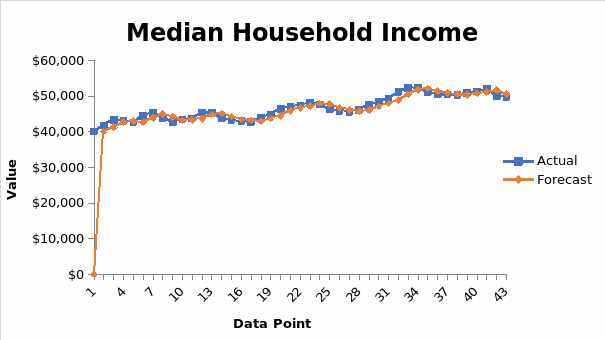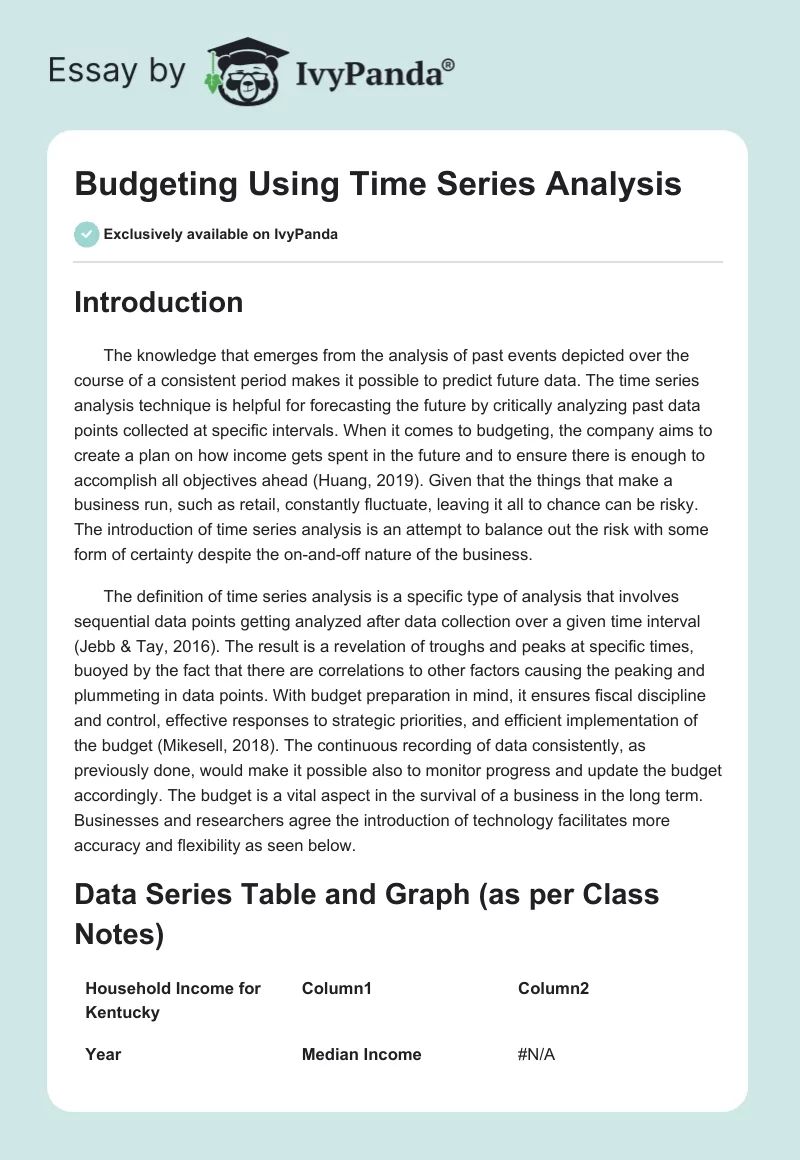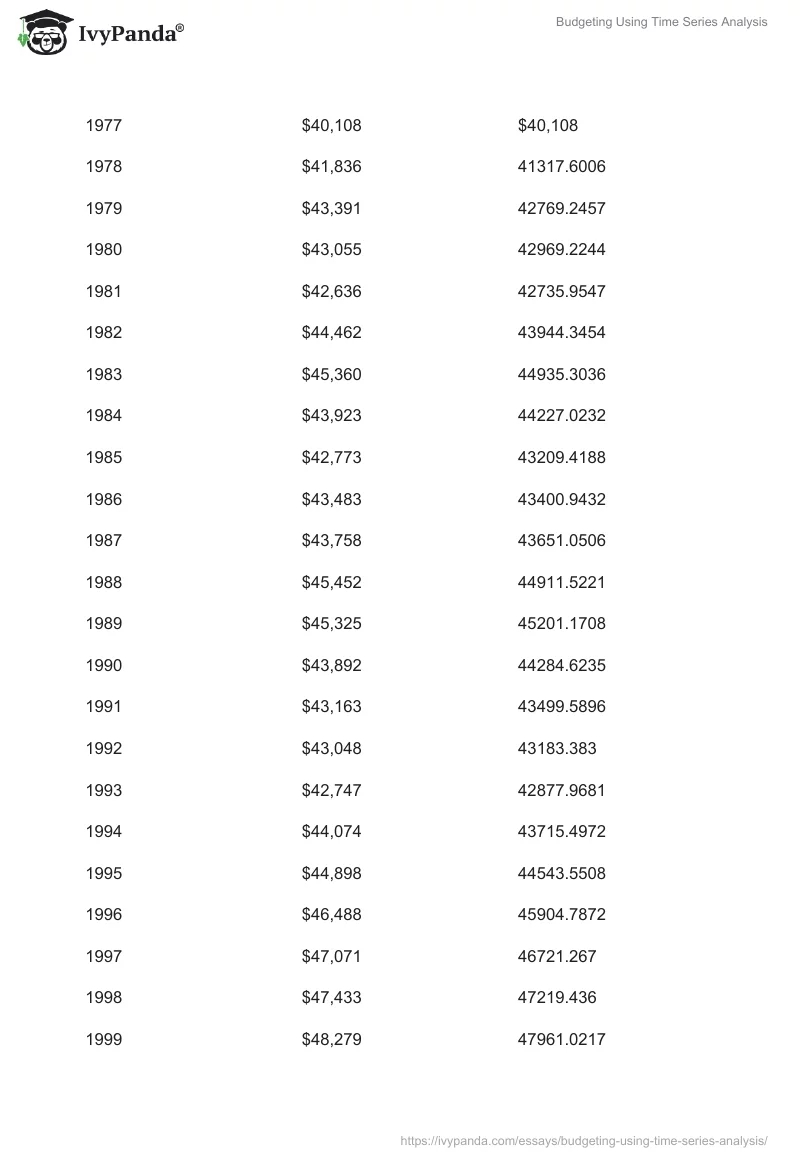Introduction
The knowledge that emerges from the analysis of past events depicted over the course of a consistent period makes it possible to predict future data. The time series analysis technique is helpful for forecasting the future by critically analyzing past data points collected at specific intervals. When it comes to budgeting, the company aims to create a plan on how income gets spent in the future and to ensure there is enough to accomplish all objectives ahead (Huang, 2019). Given that the things that make a business run, such as retail, constantly fluctuate, leaving it all to chance can be risky. The introduction of time series analysis is an attempt to balance out the risk with some form of certainty despite the on-and-off nature of the business.
The definition of time series analysis is a specific type of analysis that involves sequential data points getting analyzed after data collection over a given time interval (Jebb & Tay, 2016). The result is a revelation of troughs and peaks at specific times, buoyed by the fact that there are correlations to other factors causing the peaking and plummeting in data points. With budget preparation in mind, it ensures fiscal discipline and control, effective responses to strategic priorities, and efficient implementation of the budget (Mikesell, 2018). The continuous recording of data consistently, as previously done, would make it possible also to monitor progress and update the budget accordingly. The budget is a vital aspect in the survival of a business in the long term. Businesses and researchers agree the introduction of technology facilitates more accuracy and flexibility as seen below.
Data Series Table and Graph (as per Class Notes)

The Data Analysis
The first step in interpreting the actual results for the plot developed in the time series using data points is to look for sudden shifts and outliers. In this case, the data maintains a proportionate shift in the median household income; thus, no outliers or sudden shifts are present. The other step is the identification of the trend in data values, which offers a glimpse into what happened during a given duration. A trend accounts for a change that occurred over a long period and is visible on the time series plot in the form of a curve or a line.
Analysis of the Data Series Plot
In the time series plot above, the data provided requires using exponential smoothing to bring out the apparent upwards trend. The upward trend across the data points indicates a linear pattern of continuous increase in data values over stipulated time. The simplest forms of exponential smoothing are applicable in such an instance where the data lacks any seasonal component, and the fluctuations are a result of other variables. The data series plot helps us decipher which periods covered an upward, downward, or leveling trend and allows us to investigate what happened. The data recorded from data point 1, the year 1977, to data point 43, the year 2019, reveals the median household income grew from $40,108 to $49,777 in Kentucky.
The recorded $49,777 value for data point 43 is not the highest value that the median household income achieved during this time. The peak was in 2009 when the value was $52,388 and subsequent years experienced a dampened growth in revenue. Unfortunately, during this decade, there were two recessions, with the latter proving more damaging than the former (The Congressional Research Service, 2021). The impact was that personal income reduced drastically while the demand for government services rose despite budgetary deficits (Boylan & Ho, 2017). It meant that the country had to respond to the windfall in financial resources in various ways. With the continued realization of devolution, state expenditure had expanded and strained the federal budget, which recorded a deficit above $1 trillion as of 2010 (Joyce & Pattison, 2010). The federal and state governments needed to respond appropriately to avoid a descent into further turmoil.
Devolution meant that states were allowed to respond differently to this economic crunch, unlike during the 1929 Great Depression. It took the New Deal, backed by the federal government, to help people and state governments resume normalcy (Kurland, 2013). There was no deal this time around to save states that could not afford to weather the impact of the 2008 recession. The measures taken at each government level would have to involve spending cuts, given the diminished revenue streams. Unfortunately, spending cuts mean negative revenue swings for essential sectors such as healthcare and education (Boylan & Ho, 2017). Spending cuts mean that average households who still identify these resources as a staple part of their well-being end up paying more for basic needs.
Such moves do not occur in a vacuum, and they have been the cause of friction between local authorities and the federal government. State governments must abide by federal budget rules during challenging times to ensure long-term fiscal sustainability (Boylan & Ho, 2017). On the flip side, states end up striping entitlements like “social security, unemployment compensation, family allowances, and disability payments which contribute to social welfare to meet said standards (Schick, 2009, pg. 3).
The decision on which programs get cut involves internal politics, which, unlike the Christian principles dictate, have nothing to do with protecting the most vulnerable in society (Beed & Beed, 2010). With signs of dampened economic growth despite household spending, the bigger tragedy is that programs go unfunded, with financial struggles only being part of the problem (Rubin, 2008). It would explain the effect visible on the data series plot of a rising median beginning to weather away from the promise it showed previously.
Conclusion
In an organizational setting, time series analysis means identifying trends and the underlying causes of these changes over a given period. The visualizations developed from the data points allow the business to quickly identify when these changes occurred and how to improve or mitigate the issues. After plotting the data points based on the information provided, it becomes easier to do a deep-dive analysis of the apparent trends to identify underlying causes of changes visible. The technique makes it possible to explore the cause of the dampening growth in Kentucky’s median household income experienced between data points 35 and 43. This technique allows a short-term forecast into the future, which could allow mitigation of financial crises and ensure more fiscal prudence.
References
Beed, C., & Beed, C. (2010). Assisting the Poor to Work: A Biblical Interpretation. Christian Scholar’s Review, 13-37.
Boylan, R. T., & Ho, V. (2017). The most unkindest cut of all? State spending on health, education, and welfare during recessions. National Tax Journal, 70(2), 329-366.
Congressional Research Service. (2021). The U.S. Income Distribution: Trends and Issues. FAS Project on Government Secrecy (1991-2021). Web.
Huang, W. (2019). Developing a better planning, budgeting, and accounting system.Built on Value, 303-328. Web.
Jebb, A. T., & Tay, L. (2016). Introduction to time series analysis for organizational research. Organizational Research Methods, 20(1), 61-94. Web.
Joyce, P. G., & Pattison, S. (2010). Public budgeting in 2020: Return to equilibrium, or continued mismatch between demands and resources? Public Administration Review, 70, s24-s32.
Kurland, J. (2013). Devolution: The Retreat of Government. New England Journal of Public Policy, 24(1), 33-52.
Mikesell, J. L. (2018). Fiscal administration: Analysis and applications for the public sector (10th ed.). Boston, MA: Cengage Learning. Web.
Rubin, I. S. (2008). 22. At What Price? Costs of Federal Mandates since the 1980s. In Public budgeting: Policy, process and politics. New York, NY: Routledge. Web.
Schick, A. (2009). Budgeting for entitlements. oecd-ilibrary. Web.


